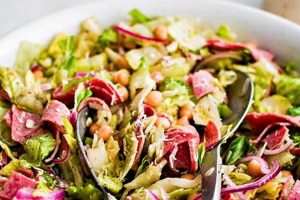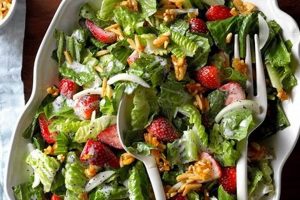A deconstructed version of the classic sandwich, this dish typically features crisp lettuce, ripe tomatoes, crumbled bacon, and creamy dressing. Variations often include other ingredients such as avocado, croutons, hard-boiled eggs, or different cheeses, offering a customizable and refreshing meal.
This salad provides a lighter alternative to the traditional sandwich while retaining its signature flavors. The combination of savory bacon, juicy tomatoes, and crunchy lettuce offers a satisfying textural contrast. Its adaptable nature allows for seasonal variations and caters to various dietary preferences through ingredient substitutions. The relative ease of preparation makes it an attractive option for quick lunches or light dinners.
The following sections will explore various aspects of this culinary creation, including ingredient selection, preparation techniques, suggested variations, and nutritional information.
Tips for an Exceptional BLT Salad
Elevating this simple salad requires attention to detail and quality ingredients. The following tips offer guidance for creating a truly satisfying culinary experience.
Tip 1: Bacon Quality is Paramount: Opt for thick-cut, high-quality bacon. Properly rendered bacon provides crucial flavor and textural depth. Avoid pre-cooked or overly thin bacon, as these options often lack the desired richness.
Tip 2: Tomato Selection Matters: Choose ripe, flavorful tomatoes, such as heirloom varieties or vine-ripened options. Their sweetness and juiciness significantly enhance the salad’s overall taste. Consider removing the seeds to prevent excess moisture.
Tip 3: Lettuce Variety Adds Complexity: While iceberg lettuce provides a classic crunch, exploring other varieties like romaine, butter lettuce, or spinach can introduce nuanced flavors and textures. A mix of greens can create a visually appealing and more nutritious salad.
Tip 4: Dressing Makes a Difference: A creamy dressing complements the smoky bacon and fresh vegetables. Classic ranch, buttermilk dressing, or a homemade blue cheese dressing are excellent choices. A light vinaigrette can offer a lighter, tangier alternative.
Tip 5: Enhance with Avocado: Adding ripe avocado provides creaminess and healthy fats. Its smooth texture contrasts beautifully with the crispy bacon and crunchy lettuce.
Tip 6: Bread Integration: Incorporating croutons or toasted bread pieces offers a textural element reminiscent of the classic sandwich. Seasoning the croutons with herbs or spices can further elevate the flavor profile.
Tip 7: Strategic Ingredient Preparation: Chop ingredients into bite-sized pieces for optimal enjoyment. This ensures even distribution of flavors and textures in each bite.
By following these suggestions, one can create a flavorful and satisfying salad that captures the essence of the beloved BLT sandwich. Attention to detail in ingredient selection and preparation elevates this simple dish into a culinary masterpiece.
These tips provide a solid foundation for crafting a delicious and satisfying BLT Salad. The concluding section offers final thoughts and encourages culinary exploration.
1. Crisp Lettuce
Crisp lettuce provides the foundation for a successful BLT salad, offering a refreshing counterpoint to the rich bacon and creamy dressing. Its textural contribution is paramount; a crisp, fresh lettuce delivers a satisfying crunch that contrasts with the other ingredients. Wilted or soggy lettuce detracts significantly from the overall experience, rendering the salad less appealing. Iceberg lettuce, with its high water content and neutral flavor, is a traditional choice. However, romaine, butter lettuce, or a blend of greens offer nuanced flavors and textures, adding complexity to the salad. The choice of lettuce impacts not only the taste and texture but also the visual appeal of the final dish.
The structural integrity of crisp lettuce also plays a critical role. It provides a bed for the other ingredients, preventing them from becoming a homogenous mixture. This separation of components allows each flavor and texture to stand out. Imagine a BLT salad with limp lettuce: the tomatoes and bacon would sink to the bottom, the dressing would saturate the leaves, and the overall presentation would be unappetizing. The crisp lettuce maintains the salad’s architecture, ensuring an enjoyable and balanced eating experience. For instance, using sturdy romaine hearts allows for attractive layering and prevents the salad from becoming overly compressed. Conversely, delicate butter lettuce, while flavorful, might require more careful handling to avoid bruising.
Ultimately, the crispness of the lettuce contributes significantly to the BLT salad’s success. It provides a refreshing textural element, structural integrity, and visual appeal. Selecting and handling the lettuce properly ensures that this crucial component enhances the overall dining experience. Choosing the right type of lettuce and ensuring its freshness elevates the salad from a simple combination of ingredients to a carefully constructed and satisfying meal.
2. Ripe Tomatoes
Ripe tomatoes contribute significantly to a successful BLT salad, providing essential sweetness, juiciness, and visual appeal. Their flavor profile, a balance of acidity and sweetness, complements the savory bacon and creamy dressing. Underripe tomatoes, lacking this delicate balance, can introduce an unpleasant tartness that detracts from the overall experience. Conversely, overripe tomatoes possess an undesirable mealy texture and may contribute excessive moisture, potentially saturating the lettuce and diluting the dressing. The selection of appropriately ripened tomatoes directly impacts the salad’s flavor profile and structural integrity.
The quality of the tomato also influences the salad’s nutritional value. Ripe tomatoes offer a rich source of vitamins and antioxidants, enhancing the dish’s health benefits. Tomatoes at peak ripeness possess higher concentrations of beneficial compounds compared to their underripe or overripe counterparts. For instance, lycopene, a potent antioxidant, is most bioavailable in fully ripened tomatoes. Therefore, selecting ripe tomatoes not only enhances the flavor and texture but also contributes to the nutritional value of the BLT salad. Furthermore, the variety of tomato chosen can introduce subtle flavor nuances. Heirloom tomatoes, known for their diverse colors and flavor profiles, can elevate the salad from a simple meal to a more complex culinary experience. The choice between a sweet Brandywine, a tangy Green Zebra, or a rich Black Krim can dramatically alter the final dish’s character.
In conclusion, the role of ripe tomatoes in a BLT salad extends beyond mere ingredient status. They represent a critical component that influences the final product’s flavor, texture, nutritional value, and overall appeal. Careful selection of ripe, high-quality tomatoes is paramount to achieving a balanced and satisfying culinary experience. Understanding the nuances of tomato ripeness and variety empowers one to craft a BLT salad that transcends the sum of its parts.
3. Crispy Bacon
Crispy bacon forms an integral part of a successful BLT salad, providing a crucial savory and textural counterpoint to the fresh vegetables and creamy dressing. Its rendering process directly influences the final dish’s overall appeal. Undercooked bacon introduces an unpleasant chewiness and lacks the characteristic smoky flavor. Conversely, overly crisp bacon crumbles excessively, hindering even distribution throughout the salad and potentially becoming burnt, imparting a bitter taste. Achieving the ideal crispness requires careful attention to cooking time and temperature. The Maillard reaction, responsible for the browning and flavor development in bacon, plays a significant role in achieving this desired crispness. This chemical process, triggered by heat, creates complex flavor compounds that contribute to the bacon’s distinctive taste.
The fat rendered during cooking contributes significantly to the salad’s flavor profile. As bacon cooks, its fat melts, infusing the surrounding ingredients with its rich, smoky essence. This rendered fat also enhances the salad’s mouthfeel, adding a subtle richness that complements the creamy dressing. Consider a scenario where pre-cooked bacon crumbles are used: while convenient, they often lack the nuanced flavor and textural contribution of freshly cooked bacon. The absence of rendered fat diminishes the salad’s overall depth of flavor and can result in a drier, less satisfying experience. Furthermore, the texture of pre-cooked bacon tends to be less consistent, often resulting in a combination of overly dry and chewy pieces.
The crispness of bacon, therefore, directly impacts the BLT salad’s sensory experience, influencing its flavor, texture, and aroma. Properly rendered bacon contributes a complex interplay of smoky, salty, and umami notes, creating a harmonious balance with the other ingredients. Attention to cooking technique ensures optimal crispness and maximizes the rendered fat’s flavor contribution. Understanding this relationship allows for a more informed approach to ingredient preparation, ultimately elevating the final dish from a simple salad to a more complex and satisfying culinary creation. This careful attention to the bacon’s preparation ensures a balanced and flavorful BLT salad experience.
4. Creamy Dressing
Creamy dressing plays a pivotal role in a successful BLT salad, binding the disparate ingredients and providing a unifying element that enhances the overall flavor profile. The dressing’s creaminess offers a textural contrast to the crisp lettuce and crunchy bacon, while its flavor complements the savory bacon, sweet tomatoes, and potentially tangy bread. This cohesive function elevates the salad beyond a simple combination of ingredients, transforming it into a harmonious and satisfying dish. Classic choices like ranch or buttermilk dressing, with their tangy and herbaceous notes, provide a familiar and well-balanced complement to the BLT’s core flavors. A blue cheese dressing, with its pungent and salty character, offers a more robust and complex flavor profile. The choice of dressing influences not only the taste but also the overall sensory experience, affecting the mouthfeel and richness of each bite. For example, a thick, mayonnaise-based dressing adds a substantial creaminess, while a thinner vinaigrette offers a lighter, tangier touch.
The dressing’s emulsifying properties contribute to the salad’s structural integrity. It helps prevent the ingredients from separating, maintaining a desirable texture and preventing the lettuce from becoming soggy. This emulsification, a mixture of oil and water-based ingredients, creates a stable dressing that coats the ingredients evenly, distributing flavor and preventing the salad from becoming watery. Imagine a BLT salad without dressing: the bacon, tomatoes, and lettuce would remain separate entities, lacking the cohesive element that transforms them into a unified dish. The dressing bridges these individual components, creating a balanced and integrated culinary experience. A thicker dressing, like a classic ranch, adheres well to the ingredients, ensuring that each bite contains a harmonious blend of flavors. Conversely, a thinner vinaigrette might require more frequent tossing to maintain even distribution.
In summary, the creamy dressing in a BLT salad serves a multifaceted purpose, contributing to flavor, texture, and structural integrity. Its ability to unify disparate ingredients, complementing their individual characteristics, transforms a simple combination of components into a cohesive and satisfying culinary creation. Selecting the appropriate dressing involves considering its flavor profile, consistency, and emulsifying properties, aligning these characteristics with the desired outcome. Understanding the dressing’s crucial role allows for a more informed and deliberate approach to BLT salad construction, resulting in a more balanced and enjoyable dining experience. The absence of a suitable dressing compromises the salad’s potential, highlighting the critical role this component plays in achieving a successful final product.
5. Flavorful Bread
Flavorful bread, though not a primary component, contributes significantly to the overall success of a BLT salad, adding a textural dimension and echoing the classic sandwich’s origin. Its presence provides a satisfying crunch that contrasts with the other ingredients, recalling the satisfying bite of a traditional BLT. This textural element elevates the salad beyond a mere deconstructed sandwich, offering a distinct, yet familiar, culinary experience. Incorporating bread also expands the flavor profile. Toasted or grilled bread introduces subtle notes of char and nuttiness, complementing the smoky bacon and fresh vegetables. The choice of bread influences these nuanced flavors; for instance, sourdough bread contributes a tangy depth, while whole-wheat bread offers a subtle nuttiness. These flavor nuances add complexity and depth to the salad, creating a more sophisticated and satisfying sensory experience. One might consider a salad featuring grilled ciabatta croutons: the char from the grill enhances the bacon’s smokiness, while the ciabatta’s airy texture provides a pleasant contrast to the crisp lettuce and creamy dressing.
The method of bread incorporation influences both texture and flavor. Croutons, offering small, crisp bites, distribute evenly throughout the salad, ensuring a consistent textural element in each bite. Larger pieces of toasted or grilled bread, on the other hand, offer a more substantial textural contrast. They can also serve as a base for layering the other ingredients, creating a visually appealing and structurally sound salad. Consider the difference between a salad with finely diced croutons and one with larger, torn pieces of grilled sourdough. The former offers a delicate crunch in every bite, while the latter provides a more robust textural experience, reminiscent of the sandwich’s structure. Furthermore, the bread’s preparation influences its ability to absorb the dressing, affecting the salad’s overall moisture content. Croutons, due to their smaller size and often toasted surface, absorb less dressing, maintaining their crispness. Larger pieces of bread, especially if not toasted, tend to absorb more dressing, potentially becoming soggy if not carefully incorporated. This consideration highlights the practical implications of bread selection and preparation in achieving the desired texture and flavor balance.
In conclusion, the strategic use of flavorful bread enhances the BLT salad, contributing textural complexity and subtle flavor nuances that elevate the overall culinary experience. Careful consideration of bread type, preparation method, and integration technique ensures that this seemingly simple addition enhances, rather than detracts from, the salad’s overall appeal. Understanding this connection allows for a more nuanced and intentional approach to constructing a BLT salad, transforming it from a basic combination of ingredients into a more refined and satisfying dish. The absence of bread, while not detrimental, represents a missed opportunity to enhance both the textural and flavor dimensions of this deconstructed classic. This nuanced understanding of bread’s contribution allows one to appreciate its seemingly understated, yet crucial role in elevating the BLT salad experience.
Frequently Asked Questions
This section addresses common inquiries regarding BLT salad preparation and variations.
Question 1: Can iceberg lettuce be substituted with other greens?
While iceberg lettuce offers a classic crunch, other greens like romaine, butter lettuce, or spinach provide alternative flavors and textures. A mix of greens can also enhance nutritional value and visual appeal.
Question 2: What are suitable dressing alternatives to ranch?
Buttermilk dressing, blue cheese dressing, or a light vinaigrette offer variations in flavor and richness. A creamy avocado dressing provides a healthier option. The choice depends on individual preference and desired flavor profile.
Question 3: How can the salad be made vegetarian?
Substituting bacon with tempeh bacon, avocado, or roasted vegetables like eggplant or mushrooms maintains the savory element while adhering to vegetarian dietary restrictions. Sun-dried tomatoes can also intensify the umami notes.
Question 4: What methods exist for enhancing the bacon’s flavor?
Smoking the bacon prior to cooking, or using flavored varieties like maple or peppered bacon, introduces additional complexity. Marinating the bacon briefly in spices or herbs before cooking can also enhance its flavor profile.
Question 5: How can the salad be made more substantial as a main course?
Adding grilled chicken, steak, or hard-boiled eggs increases protein content. Incorporating grains like quinoa or farro provides additional fiber and nutrients, transforming the salad into a more complete and satisfying meal.
Question 6: What storage recommendations apply to leftover salad?
Store ingredients separately to maintain optimal texture and prevent sogginess. Combine components just before serving. The dressing, in particular, should be stored separately and added immediately prior to consumption.
These responses provide clarity on common concerns, enabling confident preparation and customization of BLT salad. Understanding these aspects allows for greater flexibility and personalization of this versatile dish.
The following section provides a concise conclusion, summarizing key takeaways and suggesting further culinary explorations.
Conclusion
Exploration of this deconstructed classic reveals a dish offering versatility and flavor. Careful selection of ingredients, including crisp lettuce, ripe tomatoes, and properly cooked bacon, contributes significantly to the final product. The creamy dressing provides a unifying element, while the optional addition of bread introduces textural complexity. Understanding the interplay of these components allows for informed construction and customization.
The adaptability of this salad provides a canvas for culinary creativity. Exploration of ingredient variations and dressing choices allows for personalized interpretations. Continued experimentation promises further refinement and appreciation of this adaptable and satisfying dish.






